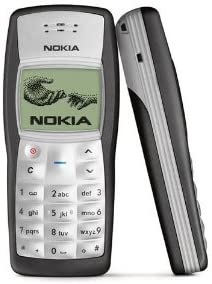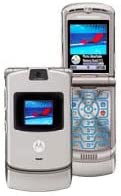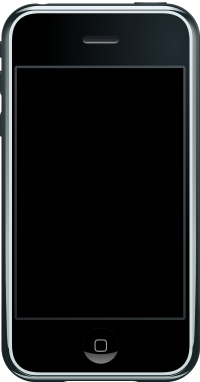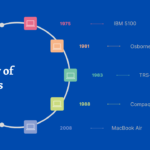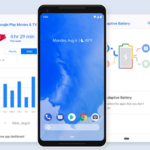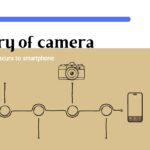Mobile phones have become an essential part of our lives, but it’s important to note that they are a relatively new technology. The modern mobile phone that we use today has only been around for the past two decades. Prior to that, mobile phones were large and bulky, and only used by a small percentage of the population. The advancements in technology have allowed for the development of smaller, more powerful mobile phones that have become ubiquitous in our daily lives. It’s amazing to think about how far mobile phone technology has come in such a short amount of time.
Timeline of Mobile Phone History
-
19731st Cellular Phone PrototypeIn 1973, Dr. Martin Cooper, an engineer working for Motorola, designed a functional mobile phone prototype. This initial model paved the way for the creation of the cell phone that we use today. During the first mobile phone call, which took place in New York City, Dr. Cooper contacted a competitor named Joel Engel from Bell Labs. This event represented the start of the mobile technology revolution that has revolutionized communication all over the world.
-
1983Motorola DynaTAC 8000XIn 1983, the Federal Communication Commission approved the first-ever mobile phone known as the Motorola DynaTAC 8000X. This handheld device was commonly referred to as “The Brick” due to its weight of almost 2 pounds. It had a battery life of only 30 minutes and was quite expensive, with a price tag of $3,995. The phone was developed in 1973 but it took 10 years for it to be approved by the FCC and made available to the public.
-
19912G, Lithium-ion BatteryFinland introduced 2G technology on the Global System for Mobile Communications. During the same year, Sony and Asahi Kasei, a renowned engineer, introduced a groundbreaking invention: the lithium-ion battery. This rechargeable and lightweight battery was a game-changer for the smartphone industry, and it is still widely used today. This innovation allowed for longer battery life, making it possible for people to use their phones for extended periods without worrying about running out of power.
-
19921st smartphone introduction, 1st SMSIn 1992, an IBM engineer named Frank Canova unveiled the first-ever prototype of a smartphone. Code-named Sweetspot, this prototype was showcased at a computer industry tradeshow and was met with success. However, it took two more years before the device was officially marketed to consumers.
That same year, another technological milestone was achieved: the first text message was sent in December 1992. It was sent by Neil Papworth, an engineer at Sema Group, and simply read “Merry Christmas”. This marked the beginning of a new era in communication, paving the way for the widespread use of SMS and texting in general. -
1994IBM Simon Personal CommunicatorThe IBM Simon Personal Communicator was released as the first smartphone for consumers. It was an upgraded version of an earlier prototype and had a touchscreen. Not only could users make phone calls, but they could also receive faxes and emails. Additionally, IBM Simon introduced the concept of apps, including an address book, calendar, calculator, appointment scheduler, and notepad. However, the phone was quite expensive, costing $1,099. Despite the high price point, it sold 50,000 units within the first six months of release.
-
1997The term “Smartphone” coinedIn 1997, the new term “smartphone” was introduced and it became widely known after three years. It was Ericsson, a Swedish telecommunications company, who coined the term to describe their latest mobile device, GS88. This phone was not only for communication but also had advanced features like internet connectivity, email, and multimedia capabilities. This era was also the beginning of mobile gaming, which allowed people to play games on their phones anytime, anywhere.
-
1998The first downloadable content on mobile phonesIn 1998, Finland’s Radiolinja introduced the first downloadable content for mobile phones – the ringtone. This paved the way for the lucrative industry that we know today.
-
1999Kyocera Visual Phone VP-210, Benefon Esc, first BlackBerry phoneThe first commercial camera phone called the Kyocera Visual Phone VP-210, was released in Japan. It had a single front-facing camera. The device could snap up to 20 photos and send them via email, or snap 2 photos per second and send them via Japan’s cellular network.
Around the same time, Benefon introduced the Benefon Esc, which was the first commercial phone equipped with GPS technology. Although primarily sold in Europe, this phone paved the way for GPS integration in mobile devices.
In 1999, the first BlackBerry phone was introduced. These phones were particularly popular among business professionals due to their convenient email service, which allowed users to read and reply to emails from any location. -
2000J-SH04 with a back-facing cameraSharp released the J-SH04 phone in Japan, which was the first phone to have a built-in camera that faced the back. This phone was a game-changer as it allowed people to take photos and instantly send them through the carrier network. The J-SH04 is known as the first camera phone that was available to the general public.
-
20013GThe mobile industry witnessed a significant advancement with the introduction of the 3G network. This network-enabled mobile phones to establish internet connections for the first time. This technological upgrade revolutionized the way people use their mobile phones and marked the beginning of the era of the mobile internet. This groundbreaking innovation created a world of endless possibilities, as people could browse the internet, stream videos, and connect with others globally without the need for a computer.
-
2003Nokia 1100Nokia introduced the 1100, a simplistic mobile phone intended for use in developing countries. Despite the passage of over fifteen years and the rise of the smartphone era, the Nokia 1100 continues to hold the title of the most popular mobile phone ever sold.
-
2004Motorola Razr V3The Motorola Razr V3 emerged as the ultimate flip phone this year. Its remarkable thinness, measuring only 14mm, was a standout feature. Additionally, its sleek aluminum casing was an uncommon sight during that era, adding to its overall appeal.
-
2007First iPhoneThe year 2007 marked a significant milestone in the world of technology with the launch of the first-ever iPhone by Apple. This model came equipped with a range of features including a touch screen, GPS, camera, internet, and an iPod. The iPhone’s innovative features and software capabilities were unprecedented, and it quickly became a game-changer in the tech world. In its initial year of release, the iPhone made a significant impression by selling over 1.4 million units.
-
2008T-Mobile G1/HTC Dream – the first Android phoneIn 2008, the first-ever mobile phone powered by the Android operating system was introduced to the market. This phone was known as the T-Mobile G1 but was also referred to as the HTC Dream. It had a touch screen and a keyboard that could be revealed by sliding the phone open. The keyboard was a QWERTY type, and there was a trackball for navigation, similar to those found on BlackBerry devices. The phone also had access to the internet.
-
20094GTelia Sonera, a Swedish company, launched the 4G network for public use. This network provided faster data transmission speeds that were approximately 10 times faster than its predecessor, 3G.
In that same year, WhatsApp made its debut in the tech world, revolutionizing the way individuals communicate by enabling them to exchange messages and make voice calls using the internet. -
20195GIn 2019, a groundbreaking achievement was made in the world of telecommunications with the launch of the first-ever 5G network by Verizon. Although initially limited in coverage to select areas in Chicago and Minneapolis, this remarkable feat marked a significant milestone in the world of technology.

